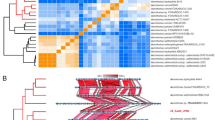Abstract
Several collections of natural isolates of the genus Salmonella and of the species Escherichia coli were studied for the release of viable temperate phages. The results indicated that functional prophage genomes may be a common constituent of all bacterial genomes of the investigated strains. About 99% of the Salmonella phages are capable of generalized transduction of chromosomal host markers and plasmids. The ratio of transducing E. coli phages is significantly lower.
Similar content being viewed by others
References
Beltran P, Plock SA, Smith NH, Whittam TS, Old DC & Selander RK (1991) Reference collection of strains of the Salmonella typhimuriumcomplex from natural populations. J. Gen. Microbiol. 137: 601-606
Bertani G & Weigle JJ (1953) Host controlled variation in bacterial viruses. J. Bacteriol. 65: 113-121
Boyd EF, Wang FS, Beltran P, Plock SA, Nelson K & Selander RK (1993) Salmonellareference collection B (SARB): strains of 37 serovars of subspecies I. J. Gen. Microbiol. 139: 1125-1132
Bullas LR & Ryu JI (1983) Salmonella typhimuriumLT2 strains which are r-m+ for all three chromosomally located systems of DNA restriction and modification. J. Bacteriol. 156: 471-474
Jackson EN, Jackson DA & Deans RJ (1978) EcoRI analysis of bacteriophage P22 DNA packaging. J. Mol. Biol. 118: 365-388
Kinkeldey U, von Lieres D & Schmieger H (1978) Bacterial donor mutants affecting the efficiency of generalized transduction by Salmonellaphage P22. J. Gen. Microbiol. 108: 227-237
Mills DM, Bajaj V & Lee CA (1995) A 40 kb chromosomal fragment encoding Salmonella typhimuriuminvasion genes is absent from the corresponding region of the Escherichia coliK-12 chromosome. Mol. Microbiol. 15: 749-759
Ochman H & Selander RK (1984) Standard reference strains of Escherichia colifrom natural populations. J. Bacteriol. 157: 690-693
Sambrook J, Fritsch EF & Maniatis T (1989) Molecular cloning. A Laboratory Manual. Cold Spring Harbor Laboratory Press, Cold Spring Harbor, New York
Schicklmaier P & Schmieger H (1995) Frequency of generalized transducing phages in natural isolates of the Salmonella typhimuriumcomplex. Appl. Environ. Microbiol. 61: 1637-1640
Shea JE, Hensel M, Gleeson C & Holden DW (1996) Identification of a virulence locus encoding a second type III secretion system in Salmonella typhimurium. Proc. Natl. Acad. Sci. U.S.A. 93: 2593-2597.
Author information
Authors and Affiliations
Rights and permissions
About this article
Cite this article
Schicklmaier, P., Moser, E., Wieland, T. et al. A comparative study on the frequency of prophages among natural isolates of Salmonella and Escherichia coli with emphasis on generalized transducers. Antonie Van Leeuwenhoek 73, 49–54 (1998). https://doi.org/10.1023/A:1000748505550
Issue Date:
DOI: https://doi.org/10.1023/A:1000748505550




